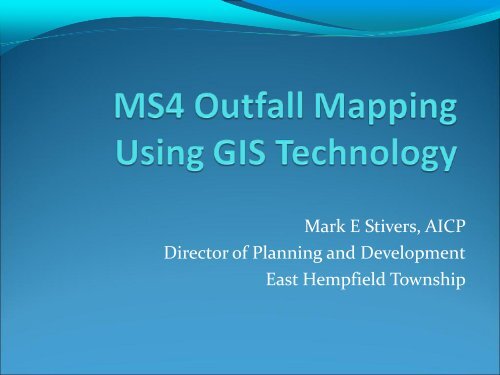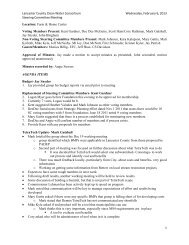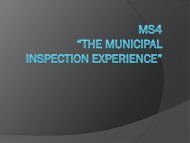MS4 Outfall & BMP Mapping Using GIS
MS4 Outfall & BMP Mapping Using GIS
MS4 Outfall & BMP Mapping Using GIS
You also want an ePaper? Increase the reach of your titles
YUMPU automatically turns print PDFs into web optimized ePapers that Google loves.
Mark E Stivers, AICP<br />
Director of Planning and Development<br />
East Hempfield Township
Mark E Stivers, AICP<br />
Director of Planning and Development<br />
East Hempfield Township
MCM#3 - ILLICIT DISCHARGE<br />
DETECTION AND ELIMINATION<br />
(IDD&E) — MINIMUM CONTROL<br />
MEASURE
MCM#3 <strong>BMP</strong>: Map all outfalls<br />
and receiving water-bodies
Where to Begin…
Data Collection – Key Terms<br />
• <strong>Outfall</strong> -A point source as defined by 40 CFR 122.2 at the point<br />
where a municipal separate storm sewer discharges to waters of<br />
the United States and does not include open conveyances<br />
connecting two municipal separate storm sewers, or pipes,<br />
tunnels or other conveyances which connect segments of the<br />
same stream or other waters of the United States and are used to<br />
convey waters of the United States.<br />
• Point Source - any discernable, confined and discrete<br />
conveyance, including but not limited to any pipe, ditch,<br />
channel, tunnel, conduit, well, discrete fissure, container, rolling<br />
stock, concentrated animal feeding operation, vessel, or other<br />
floating craft from which pollutants are or may be discharged.
Data Collection – Key Terms<br />
• Pollutant - dredged spoil, solid waste, incinerator residue, filter<br />
backwash, sewage, garbage, sewage sludge, munitions, chemical<br />
wastes, biological materials, radioactive materials (except those<br />
regulated under the Atomic Energy Act of 1954, as amended (42<br />
U.S.C. 2011 et seq.)), heat, wrecked or discarded equipment, rock,<br />
sand, cellar dirt and industrial, municipal, and agricultural waste<br />
discharged into water.
Data Collection
Data Collection<br />
• Identify major and minor drainage basins.<br />
• Identify major waterways within the drainage basins<br />
(Receiving Bodies of Water)<br />
• Develop a plan to systematically walk each stream and<br />
identify each outfall.
Data Collection – Drainage Basins
Data Collection – Receiving Water<br />
Bodies
Data Collection – Collecting <strong>Outfall</strong><br />
Data
Data Collection – Collecting <strong>Outfall</strong><br />
Data<br />
• We utilized our Township Engineer, RAV Associates to<br />
collect the data for the outfalls.<br />
• They collected location and site condition data on 353<br />
outfalls.<br />
• They then created data points for each outfall.<br />
• They numbered each outfall.<br />
• They filled out a field sheet for each outfall.
Data Collection – Collecting <strong>Outfall</strong><br />
Data<br />
ILLICIT DISCHARGE FIELD SCREENING PROGRAM<br />
Data Collection Form<br />
OUTFALL #: Date: Time:<br />
TIME SINCE LAST RAIN: 72 hours 72 hours<br />
QUANTITY OF LAST RAIN: 0.1 inches 0.1 inches<br />
INSPECTION TEAM:<br />
SITE DESCRIPTION:<br />
LOCATION (Narrative Description):<br />
STRUCTURE TYPE: OPEN CHANNEL MANHOLE OUTFALL OTHER:<br />
DOMINANT WATERSHED LAND USES: INDUSTRIAL COMMERCIAL RESIDENTIAL UNKNOWN<br />
OTHER:<br />
FLOW ESTIMATION:<br />
WAS FLOW OBSERVED? NO YES IF YES, PLEASE ANSWER a. - d. BELOW.<br />
a. WIDTH OF WATER SURFACE (feet):<br />
b. APPROXIMATE DEPTH OF WATER (feet):<br />
c. APPROXIMATE FLOW VELOCITY (feet per second):<br />
d. FLOW RATE (cubic feet per second) = a x b x c =<br />
VISUAL OBSERVATIONS:<br />
WAS A PHOTO TAKEN? NO YES (Roll and Photo Number: )<br />
ODOR: NONE MUSTY SEWAGE ROTTEN EGGS SOUR MILK OTHER:<br />
COLOR: CLEAR RED YELLOW BROWN GREEN GREY OTHER:<br />
CLARITY: CLEAR CLOUDY OPAQUE<br />
FLOATABLES: NONE OILY SHEEN GARBAGE/SEWAGE OTHER:<br />
DEPOSITS/STAINS: NONE SEDIMENTS OILY OTHER:<br />
VEGETATION CONDITION: NONE NORMAL EXCESSIVE GROWTH INHIBITED GROWTH<br />
STRUCTURAL CONDITION: NORMAL CONCRETE CRACKING METAL CORROSION OTHER:<br />
BIOLOGICAL: MOSQUITO LARVAE BACTERIA/ALGAE OTHER:<br />
FIELD ANALYSIS:<br />
WATER TEMP: F / C CHLORINE (Total): mg/l<br />
pH: COPPER: mg/l<br />
PHENOL: mg/l DETERGENTS: mg/l<br />
WAS A LABORATORY SAMPLE COLLECTED? NO YES<br />
(if yes attach copy of chain-of-custody record)<br />
COMMENTS:<br />
DATA SHEET FILLED OUT BY: (signature):<br />
DATE:<br />
(print name):
Data Collection – <strong>Outfall</strong> Map<br />
• Next, we created a map showing all the outfalls. This<br />
included data such as site number, type of structure,<br />
and if it is a dry weather flow.<br />
• A dry weather flow is an outfall that has water flowing<br />
when there has been no rain for at least three days.
Data Collection – <strong>Outfall</strong> Map<br />
• What Should My Map Look Like? Understanding the location of your<br />
separate storm sewer system outfalls is the key to effectively managing<br />
stormwater runoff and protecting water quality. Not all system maps will look<br />
alike, but they should contain the same basic information and ultimately serve<br />
as a tool for your employees responsible for implementing the IDD&E Program<br />
(Illicit Discharge Detection & Elimination), as well as other components of the<br />
Stormwater Management Program.<br />
• SCALE. The map must be of a scale that shows street-level detail and extends<br />
beyond the service boundaries of the municipal storm sewer system. A scale<br />
between 1:10,000 and 1:25,000 may be appropriate for many small <strong>MS4</strong>s that<br />
cover a large land area. This scale is acceptable as long as street-level detail can<br />
be obtained. Otherwise you should use a map scale that best depicts specific<br />
location information for each outfall, as technicians in the field will need<br />
street-level detail in order to effectively locate and monitor outfalls.
Data Collection – <strong>Outfall</strong> Map<br />
• SYSTEM FEATURES. The goal of the system mapping is to identify all outfalls<br />
and the name/location of the receiving water bodies, to support an effort to<br />
detect and eliminate illicit discharges.<br />
• FORMAT. Only you can determine what format is best for your community.<br />
Factors such as staff, money, format of available data and equipment will<br />
dictate how you generate your system map. You may wish to use a geographic<br />
information system (<strong>GIS</strong>) to electronically generate your system map. PA DEP<br />
recognizes that not all communities have <strong>GIS</strong> capabilities. For those that do not<br />
have <strong>GIS</strong> capabilities, you can generate your map using other means. The<br />
format of your map is not as important as the quality of the information it<br />
contains. For help with developing your system map, consult the list of<br />
resources provided in Appendix 1.
Data Collection – Collecting <strong>Outfall</strong><br />
Data
Data Collection – Collecting <strong>Outfall</strong><br />
Data
Data Collection – Collecting <strong>BMP</strong><br />
Data<br />
• Next Step in the process was<br />
collecting the <strong>BMP</strong> data.<br />
• We were able to hire a summer intern<br />
from Millersville University to help<br />
with the Data Collection.<br />
• We began by pulling together a list of<br />
all the Land Development Plans that<br />
were recorded within the designated<br />
time period.
Data Collection – Collecting <strong>BMP</strong><br />
Data<br />
• We developed an Excel Table to track the data.<br />
• Data included Parcel Number, Plan Number, Location of<br />
File, and Plan Name<br />
Parc_Numb Plan_Numb Stor_Loc Plan_Name<br />
2909818000000 06-122-FP Box_62 CFC<br />
2905976300000 04-49-FP Box_73 Hassel_Tract<br />
2908077300000 03-30-FP SALDO Brub_BP<br />
2900193100000 09-19-RFP Filing_Cab Nool_L_1<br />
2902695300000 05-94-FLD SALDO<br />
2906930300000 06-114-FP Filing_Cab SKH<br />
2907311700000 03-44-FLD Box_25 Regen_Sq<br />
2902016000000 05-59-FP Filing_Cab Hayden_Mnr<br />
2901665200000 04-52-FLD SALDO Mear_Kia<br />
2903034400000 03-45-FLD SALDO Lacn_Toy<br />
2901227100000 09-03-FP Filing_Cab Gold_Mead_P<br />
2908429800000 05-73-FLD Box_79 St_Edwards<br />
2901389700000 03-24-FP SALDO Winde_Pl<br />
2904352700000 05-95-FP Filing_Cab HSD<br />
2903496400000 06-116-FP Filing_Cab Hemp_Cross<br />
2901638700000 05-99-FLD Filing_Cab Union_Natl<br />
2903863900000 04-63-FLD SALDO LASA<br />
2905950100000 03-43-FLD Box_31 BJs<br />
2909456600000 05-93-FLD Filing_Cab SHEETZ<br />
2900972400000 06-83-FLD/07-151-FP Filing_Cab The_Arbors<br />
2903762400000 06-120-FP/03-41-FP SALDO Vill_Grande<br />
2908310100000 04-55-FP Box_74 Porter_Trt
Data Collection – Collecting <strong>BMP</strong><br />
Data<br />
• Next the Intern made a copy of the recorded Land<br />
Development Plan and Identified the <strong>BMP</strong>s .<br />
Swale<br />
Basin<br />
End Wall
Data Collection – Collecting <strong>BMP</strong><br />
Data<br />
Swale<br />
Basin<br />
End Wall
Data Collection – Collecting <strong>BMP</strong><br />
Data<br />
• Next we merged the Excel Table with the <strong>GIS</strong> parcel<br />
data to create a new <strong>GIS</strong> layer.<br />
• We used the Account Number as the Key Field for the<br />
merge (Join in <strong>GIS</strong> lingo).
Data Collection – Collecting <strong>BMP</strong><br />
Data
Data Collection – Collecting <strong>BMP</strong><br />
Data
Data Collection – Collecting <strong>BMP</strong><br />
Data
Data Collection – Collecting <strong>BMP</strong><br />
Data
Data Collection<br />
Trimble® GeoXH® 2008
Data Collection – Collecting <strong>BMP</strong><br />
Data<br />
• Next steps is taking samples of dry weather flows.<br />
• To do this we use the GPS to locate the outfalls.<br />
• Photos are taken at each location and attached to the<br />
record.<br />
• A file is kept for record keeping and any needed<br />
follow-up.
Contact info :<br />
markstivers@easthempfield.org<br />
717.898.3100





